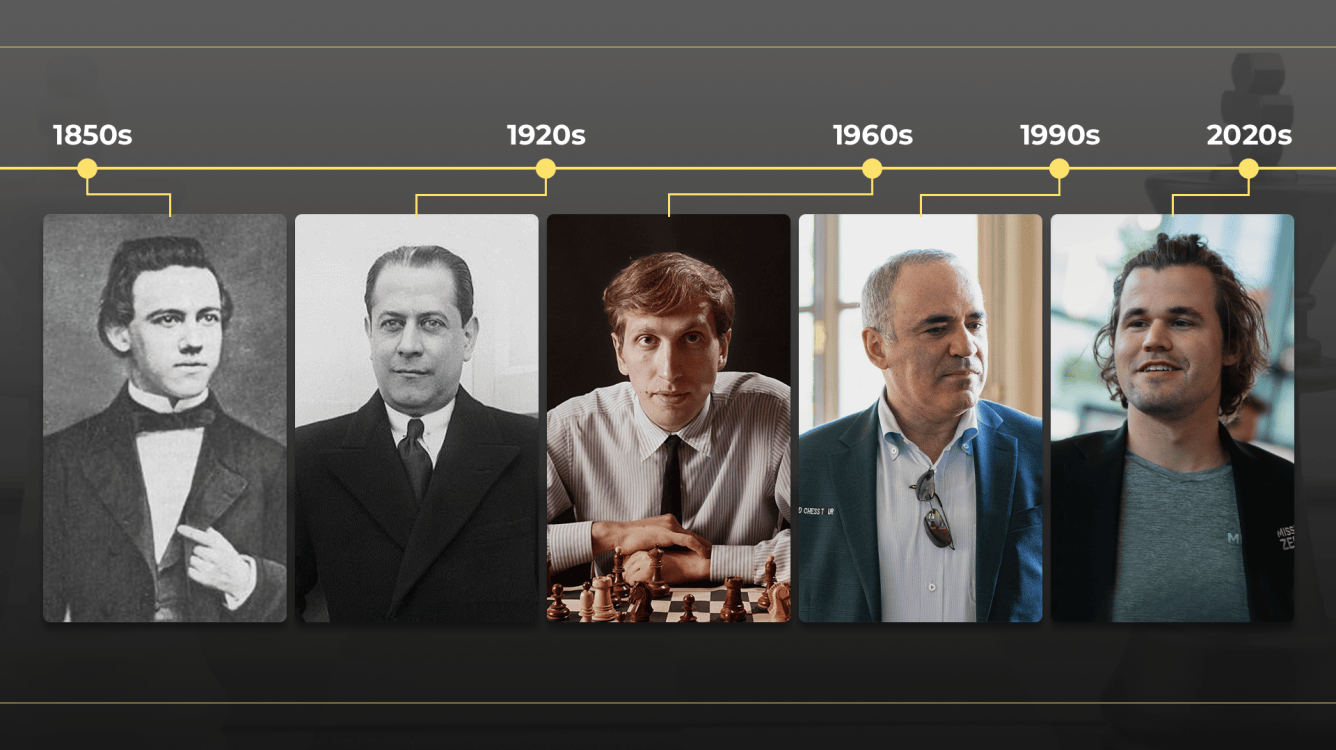
Every Chess 'Player Of The Decade' (From Morphy To Magnus)
Who is the best? It's a question we ask about almost every competitive endeavor, and chess is no exception. For many years, we here at Chess.com have bestowed the Chess.com Awards at the end of every year. But it's time to think with longer timescales.
Most major sports leagues have something called All-Decade teams, which feature the best players from each decade of the league's existence. Why isn't there one for chess? Well, we now have at least a Player Of The Decade. Our game has been around too long to pick every decade—Player of the 1350s? Sorry, we're more worried about surviving the plague—so we had to start somewhere.
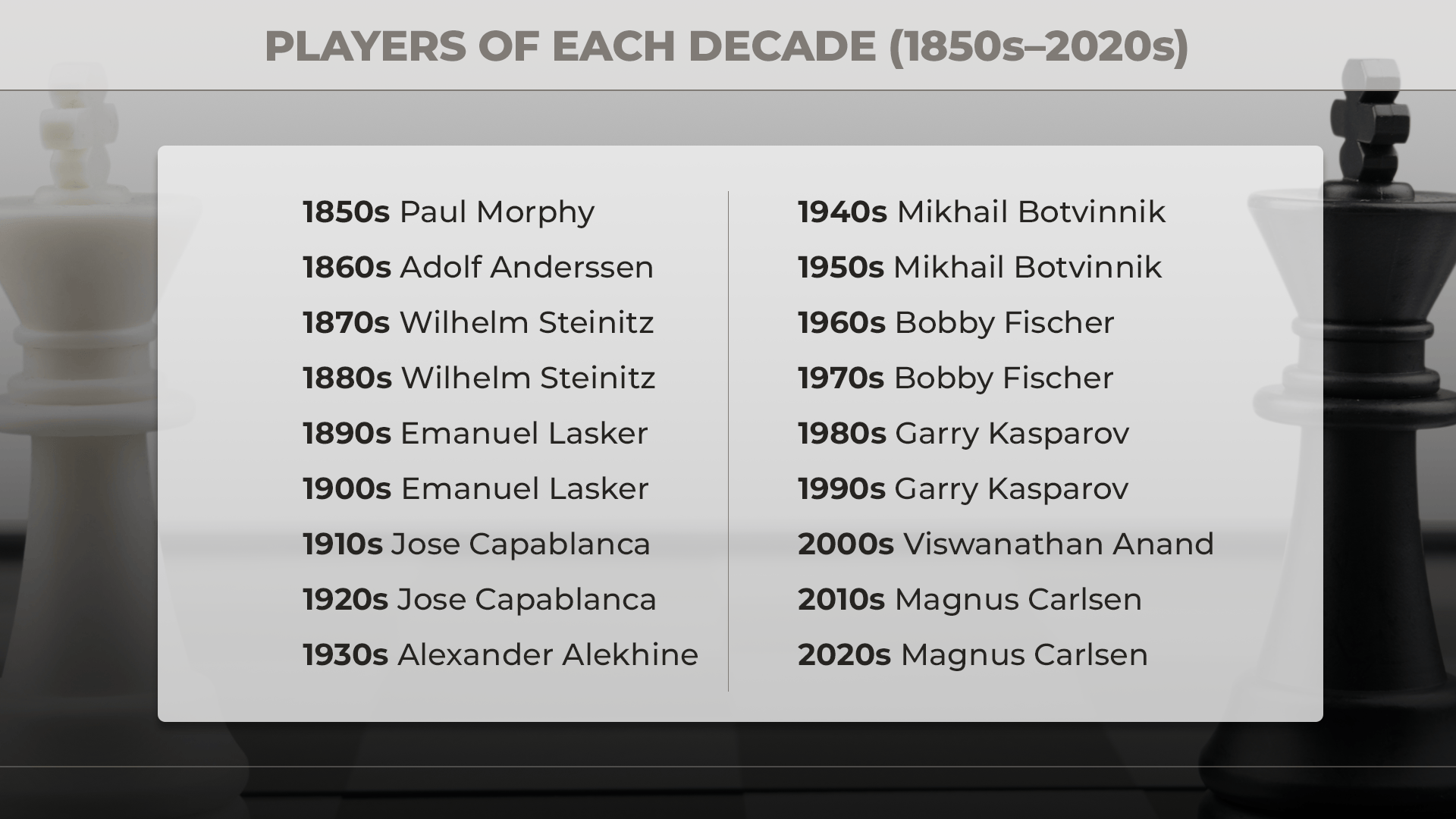
Players were chosen by a panel of 33 Chess.com staff members, including 15 titled players and three grandmasters. Some of our top people were on the case, among them IM Danny Rensch, FM James Canty, FM Mike Klein, NM Sam Copeland, and Peter Doggers.
Voters were asked to consider three different criteria but were not told how to balance them. The criteria for judging players were:
- Peak performance in the decade
- Consistent performance throughout the decade
- Identification of the player with the chess culture of that decade
NOTE: In the following tables, Peak Rating and Years as #1 are based on Jeff Sonas' ChessMetrics.com from the 1850s through the 1990s. From the 2000s onward, FIDE ratings are used.
Skip to a decade: 1850s | 1860s | 1870s | 1880s | 1890s | 1900s | 1910s | 1920s | 1930s | 1940s | 1950s | 1960s | 1970s | 1980s | 1990s | 2000s | 2010s | 2020s
1850s
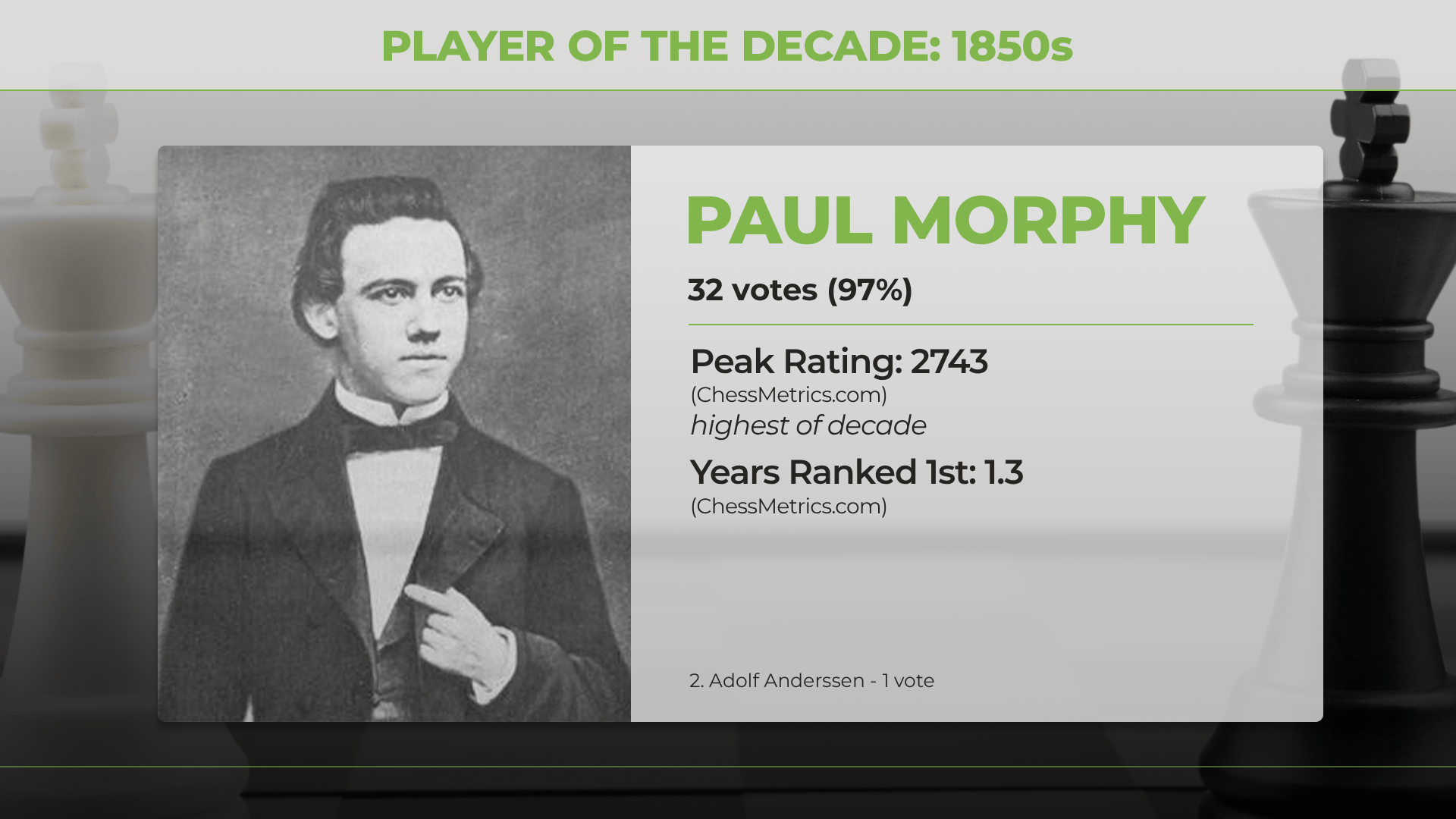
Statistically, Paul Morphy is the weakest Player Of The Decade, but that's only because he didn't play very much. Realistically, no one was better in the 1850s. He was only 12 years old at the start of the decade but already a prodigious talent, defeating one of the top masters of the day (Johann Loewenthal) in two games without losing. His 7–2 rout of Adolf Anderssen in 1858 proved who the world's best player was. And Morphy's legend continues to this day.
Anderssen, who won the first major international tournament in London 1851 and produced both the "Immortal Game" and "Evergreen Game," was the only other player to receive a vote.
Staff comment: Paul Morphy is probably the player of the century because of how dominant he was, getting to GM-level without nearly as many books, theory, etc. – Pedro Nami
| Rank | Player | Votes | Vote % | Titled Votes | Years #1 | Peak Rating | WC Wins |
| 1 | Paul Morphy | 32 | 97% | 15 | 1.3 | 2743 | - |
| 2 | Adolf Anderssen | 1 | 3% | 0 | 0.0 | 2657 | - |
Morphy was one of just two players to win 32 or more votes and unanimously win the titled player vote.
1860s
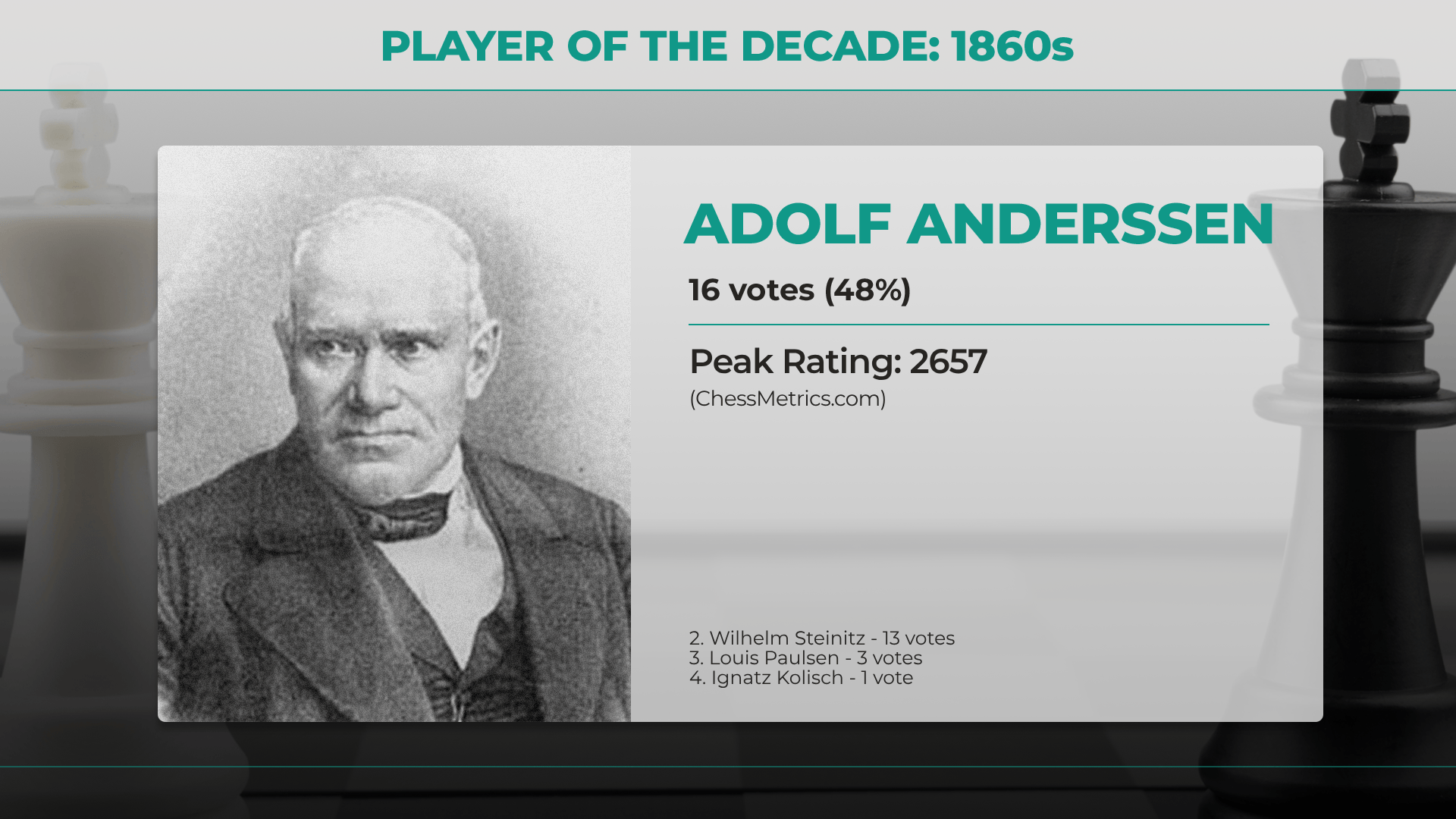
Morphy was so dominant that, without him, the 1860s were a big letdown compared to the 1850s. Anderssen was no longer the same player from London 1851, but in the 1862 tournament in the same city, he was still good enough to win. Wilhelm Steinitz narrowly defeated him in a match in 1866, but it wasn't enough to claim the decade.
That said, this was the closest vote between first and second in the entire exercise. Just two people changing their votes from Anderssen to Steinitz would have changed the result.
But what about... Ignatz Kolisch? Kolisch, often forgotten among the chess titans of the 1800s, dominated tournaments in the 1860s and bridged the gap between Morphy and Anderssen. – FM Jack Rodgers
| Rank | Player | Votes | Vote % | Titled Votes | Years #1 | Peak Rating | WC Wins |
| 1 | Adolf Anderssen | 16 | 48% | 8 | 0.0 | 2657 | - |
| 2 | Wilhelm Steinitz | 13 | 39% | 4 | 1.3 | 2743 | - |
| 3 | Louis Paulsen | 3 | 9% | 2 | 3.2 | 2710 | - |
| 4 | Ignatz Kolisch | 1 | 3% | 1 | 1.3 | 2755 | - |
1870s
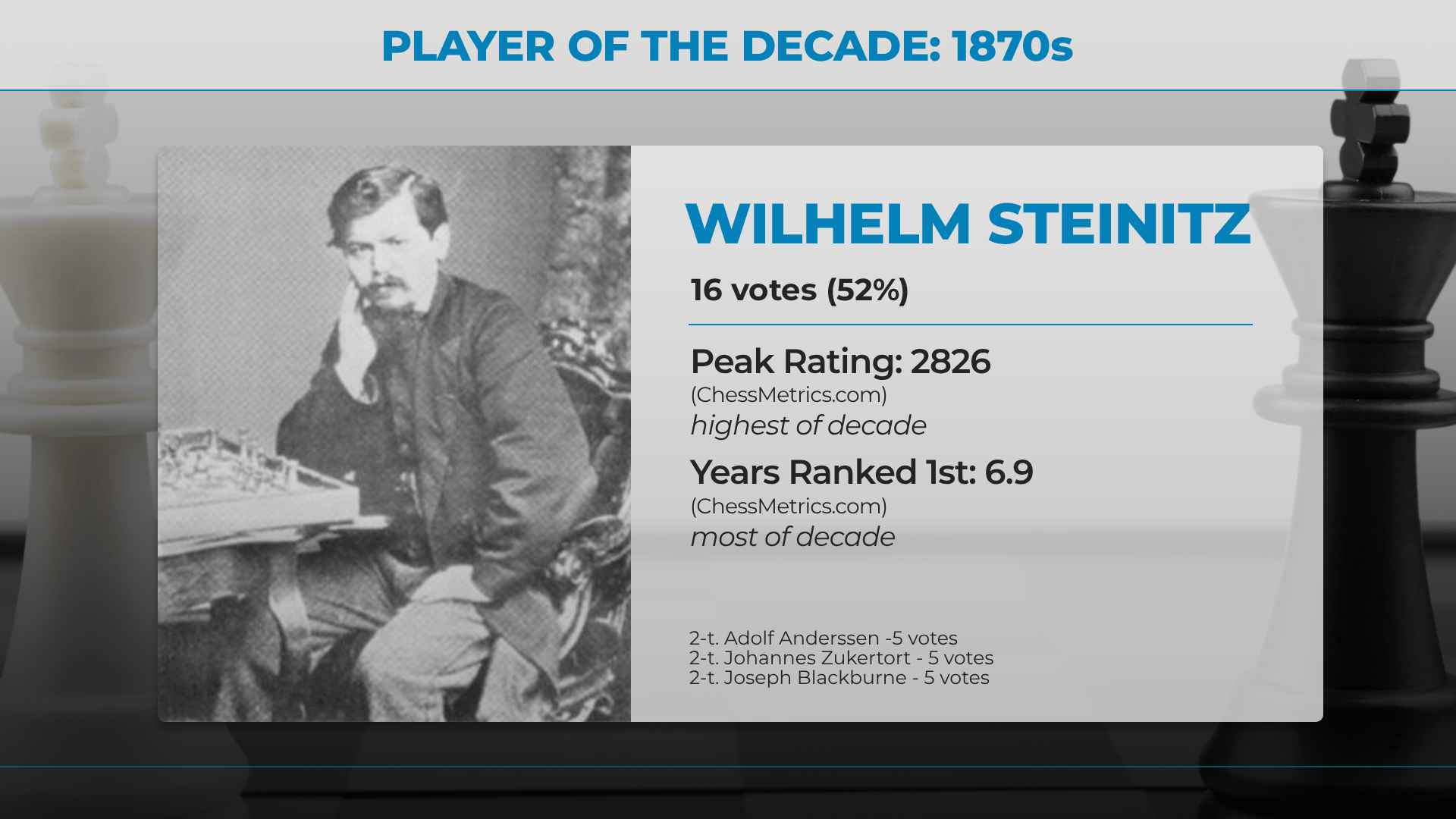
Steinitz arguably reinvented chess in 1873 with his positional style at Vienna. Not only did he win that event with his change in play, but he also won convincingly. In the unusual tournament format, Steinitz scored 83 percent in his 27 games played, while second-place Joseph Blackburne scored 67 percent in his 32 games.
As several voters pointed out, Steinitz didn't play much in the decade after that tournament. The baseline he established, however, ultimately gave him a majority of the vote and a relatively comfortable margin over the three-way tie for second place.
But what about... Johannes Zukertort? The 1870s are tricky because Steinitz crushed Zukertort in a match in the early 1870s, but then Steinitz didn't play from 1873-1880. And Zukertort won a few big events. So I think it is hard to give "player of the decade" to someone who only played a few years. For me, Zukertort's entire body of work takes it. – FM Mike Klein
| Rank | Player | Votes | Vote % | Titled Votes | Years #1 | Peak Rating | WC Wins |
| 1 | Wilhelm Steinitz | 16 | 52% | 7 | 6.9 | 2826 | - |
| 2 | Adolf Anderssen | 5 | 16% | 4 | 0.3 | 2744 | - |
| 3 | Johannes Zukertort | 5 | 16% | 2 | 1.4 | 2749 | - |
| 4 | Joseph Blackburne | 5 | 16% | 1 | 0.0 | 2673 | - |
| - | No opinion | 2 | - | - | - | - | - |
1880s

Steinitz wins again in the 1880s, this time a pretty easy call for our voters. After all, Steinitz became the first official world champion in 1886.
That match was borne out of the results at Vienna 1882 and London 1883, won by Steinitz and Johannes Zukertort, respectively. Although Zukertort came out ahead at London and took a 4–1 lead in their match three years later, Steinitz vanquished him and then confirmed his pole position in the decade with a title defense in 1889 against Mikhail Chigorin.
| Rank | Player | Votes | Vote % | Titled Votes | Years #1 | Peak Rating | WC Wins |
| 1 | Wilhelm Steinitz | 27 | 87% | 11 | 6.7 | 2826 | 2 |
| 2 | Johannes Zukertort | 3 | 10% | 2 | 3.2 | 2798 | 0 |
| 3 | Isidor Gunsberg | 1 | 3% | 1 | 0.1 | 2744 | 0 |
| - | no opinion | 2 | - | - | - | - | - |
1890s

By the end of the 1880s, a German player named Emanuel Lasker was already making a name for himself with games like the one against Johann Bauer. Although it took him until 1894 to get a match with Steinitz and win, he reached Chess Metrics #1 in June 1890. After beating Steinitz, Lasker spent the rest of the 19th century crushing tournaments from St. Petersburg 1896 to London 1899, as well as winning a rematch with Steinitz.
But what about... Harry Pillsbury? Tragically, Pillsbury died very young. I think he could have challenged Steinitz/Lasker for the world championship. His incredible feats of memorization boggle my mind. – Tom Shupe
| Rank | Player | Votes | Vote % | Titled Votes | Years #1 | Peak Rating | WC Wins |
| 1 | Emanuel Lasker | 22 | 71% | 10 | 9.6 | 2878 | 2 |
| 2 | Siegbert Tarrasch | 4 | 13% | 2 | 0.0 | 2824 | 0 |
| 3 | Wilhelm Steinitz | 3 | 10% | 1 | 0.4 | 2765 | 2 |
| 4 | Mikhail Chigorin | 1 | 3% | 1 | 0.0 | 2797 | 0 |
| 5 | Harry Pillsbury | 1 | 3% | 0 | 0.0 | 2797 | 0 |
| - | No opinion | 2 | - | - | - | - | - |
1900s

Into the 20th century, no one caught up with Lasker despite his taking years away from a chess career to focus on his academic career. When he returned, he defended his championship twice in two years, 8–0 in 1907 against Frank Marshall and 8–3 in 1908 against Siegbert Tarrasch. (Lasker defended two additional times in 1910.) And yet the player the metrics favors during Lasker's pause, GM Geza Maroczy, didn't get any of those matches. Too bad for him.
But what about... GM Akiba Rubinstein? Lasker hardly played, apart from his world championships. Rubinstein played his brilliancy against Rotlewi and tied for first with Lasker at the Chigorin Memorial in 1909 (but beat Lasker) where he demonstrated some of his famous rook endings. – Peter Doggers
| Rank | Player | Votes | Vote % | Titled Votes | Years #1 | Peak Rating | WC Wins |
| 1 | Emanuel Lasker | 24 | 75% | 10 | 5.4 | 2869 | 2 |
| 2 | Akiba Rubinstein | 4 | 13% | 3 | 0.3 | 2780 | 0 |
| 3 | Frank Marshall | 2 | 6% | 0 | 0.0 | 2738 | 0 |
| 4 | Siegbert Tarrasch | 1 | 3% | 1 | 0.0 | 2814 | 0 |
| 4 | Geza Maroczy | 1 | 3% | 0 | 2.5 | 2820 | 0 |
| - | No opinion | 1 | - | - | - | - | - |
1910s

Lasker remained champion throughout the entire 1910s, but was starting to feel the heat from multiple players—Jose Capablanca and GM Akiba Rubinstein, mostly—and may have lost the title sooner had the First World War not happened. By 1911, the 22-year-old Capablanca was already being invited to and winning the best tournaments (something really achieved before him at that age by only Morphy and Pillsbury).
Capa continued to dominate for the rest of the decade. But it was Rubinstein who was supposed to play Lasker around 1914. After the war, Capablanca got his chance, but Rubinstein never did.
In terms of the votes, there was also some Lasker fatigue. No player in this exercise managed to win Player Of The Decade in three straight decades.
Staff comment: If someone picks anyone other than Capa for the '10s and '20s, I'm not sure we can be friends. – FM Mike Klein
| Rank | Player | Votes | Vote % | Titled Votes | Years #1 | Peak Rating | WC Wins |
| 1 | Jose Capablanca | 20 | 61% | 7 | 1.7 | 2873 | 0 |
| 2 | Emanuel Lasker | 6 | 18% | 3 | 6.6 | 2860 | 2 |
| 3 | Akiba Rubinstein | 5 | 15% | 3 | 1.8 | 2789 | 0 |
| 4 | Alexander Alekhine | 1 | 3% | 1 | 0.0 | 2781 | 0 |
| 4 | Frank Marshall | 1 | 3% | 1 | 0.0 | 2762 | 0 |
1920s
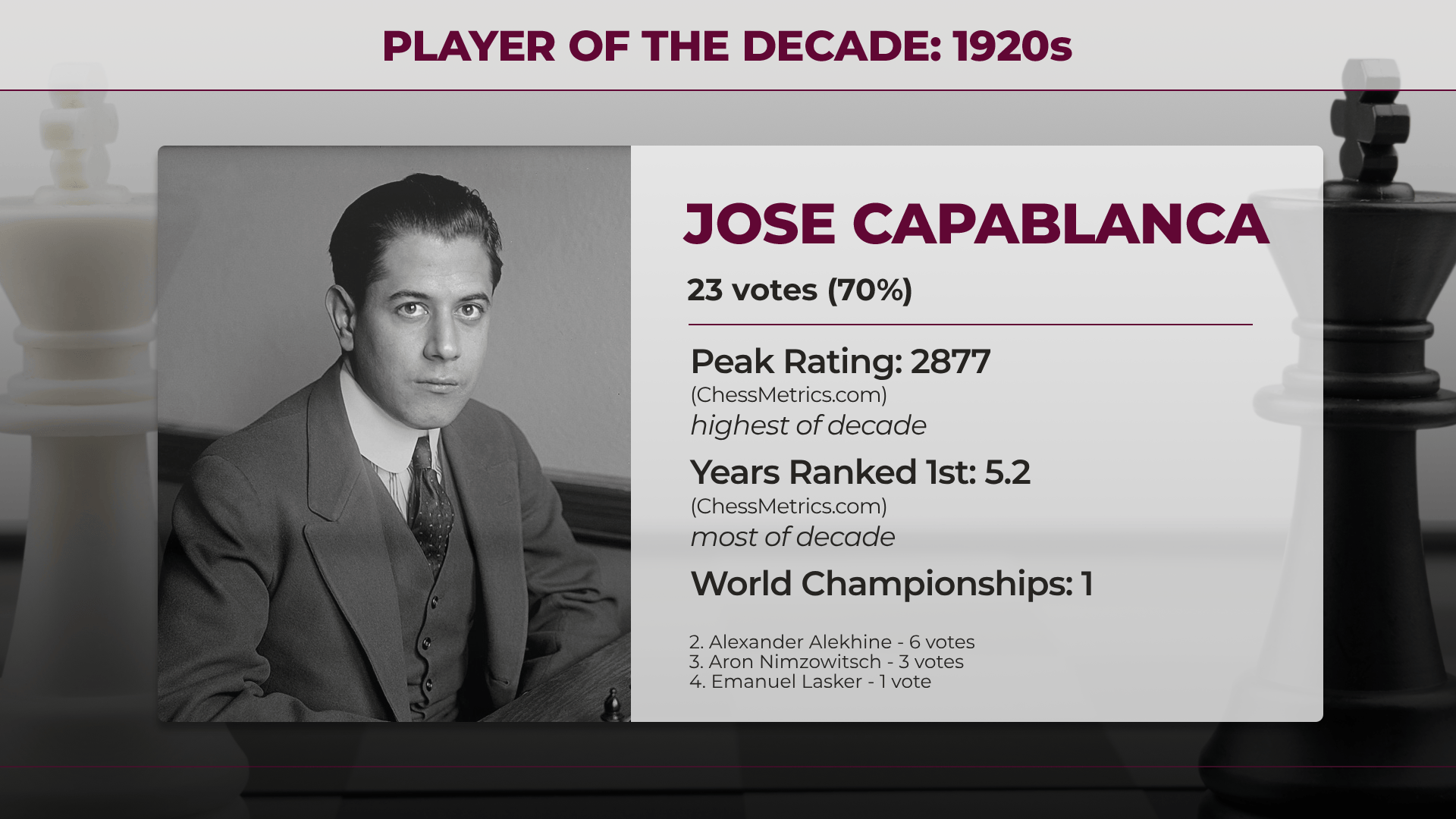
Capablanca's famous eight-year undefeated streak lasted from 1916 to 1924, splitting two decades perfectly. It helped him get Player Of The Decade in both decades. And where he won in the 1910s on the promise of becoming world champion, the 1920s is when he actually did it, in a relatively easy win over Lasker in 1921.
Even though Capablanca would lose to Alexander Alekhine in 1927, his score throughout the '20s—number one for longer with a higher peak—helped the Cuban to outrank the Russian fairly easily.
| Rank | Player | Votes | Vote % | Titled Votes | Years #1 | Peak Rating | WC Wins |
| 1 | Jose Capablanca | 23 | 70% | 11 | 5.2 | 2877 | 1 |
| 2 | Alexander Alekhine | 6 | 18% | 2 | 1.9 | 2821 | 2 |
| 3 | Aron Nimzowitsch | 3 | 9% | 1 | 0.0 | 2780 | 0 |
| 4 | Emanuel Lasker | 1 | 3% | 1 | 2.8 | 2833 | 0 |
1930s

Despite his slipup against GM Max Euwe in 1935, Alekhine was the dominant force of the 1930s, especially early on, when he won at San Remo by 3.5 points in 1930 and at Bled by 5.5 points in 1931.
Of course, Alekhine didn't play Capablanca between 1927 and 1936, so it is hard to compare the two directly. Nonetheless, Alekhine enjoys a wider margin in the 1930s vote than Capablanca in the '20s. And no one considered poor Euwe as Player Of The Decade for beating Alekhine—well, almost no one.
But what about... Capablanca? I think Capablanca would have reclaimed the world championship in the early 1930s if Alekhine did not avoid playing him. – Tom Shupe
| Rank | Player | Votes | Vote % | Titled Votes | Years #1 | Peak Rating | WC Wins |
| 1 | Alexander Alekhine | 23 | 72% | 10 | 6.9 | 2860 | 2 |
| 2 | Jose Capablanca | 4 | 13% | 2 | 0.3 | 2804 | 0 |
| 3 | Mikhail Botvinnik | 3 | 9% | 2 | 1.7 | 2780 | 0 |
| 4 | Paul Keres | 1 | 3% | 1 | 0.0 | 2733 | 0 |
| 4 | Max Euwe | 1 | 3% | 0 | 1.2 | 2769 | 1 |
| - | No opinion | 1 | - |
1940s

The 1940s were, because of World War II, a difficult decade, to say the least. The players are a bit tough to rank for the same reason—after number one. By the late 1930s, GM Mikhail Botvinnik and other players born in the 20th century were passing the esteemed Lasker–Capablanca–Alekhine triumvirate; those three died in 1941, 1942, and 1946, respectively.
When Botvinnik won the 1948 World Championship by a 3.5-point margin, he firmly established himself as the top post-war player. Several other players received votes, but Botvinnik won a majority.
But what about... GM Miguel Najdorf? Najdorf left a huge legacy with his Sicilian line. – WIM Ayelen Martinez
| Rank | Player | Votes | Vote % | Titled Votes | Years #1 | Peak Rating | WC Wins |
| 1 | Mikhail Botvinnik | 18 | 56% | 8 | 7.8 | 2885 | 1 |
| 2 | Alexander Alekhine | 5 | 16% | 3 | 1.3 | 2807 | 0 |
| 3 | Miguel Najdorf | 3 | 9% | 2 | 0.0 | 2797 | 0 |
| 4 | Paul Keres | 3 | 9% | 1 | 0.0 | 2786 | 0 |
| 5 | Max Euwe | 2 | 6% | 0 | 0.0 | 2763 | 0 |
| 6 | Reuben Fine | 1 | 3% | 1 | 0.5 | 2762 | 0 |
| - | No opinion | 1 | - |
1950s

We come to the most disputed decade of them all. Botvinnik's nine years in the decade as world champion won out over the two players who displaced him for a year, GMs Vasily Smyslov and Mikhail Tal (albeit Tal's championship coming at the beginning of the 1960s). Those two combined for more votes than Botvinnik, 15-13, making this the only decade where second and third combined for more votes than the winner.
Smyslov played more memorable games than Botvinnik during the '50s, and in their three world championship matches, he actually won more games. Smyslov won two Candidates tournaments and was a more active tournament player overall. Botvinnik, with his status as the world champion, was the stronger cultural representative of chess throughout the decade, however. And while Botvinnik probably couldn't beat Tal on the cultural point, Tal emerged quite late in the decade.
But what about... GM David Bronstein? I love Bronstein. Can't help myself. It wasn't data-driven. It was a man-crush. – Mike Klein
| Rank | Player | Votes | Vote % | Titled Votes | Years #1 | Peak Rating | WC Wins |
| 1 | Mikhail Botvinnik | 13 | 41% | 6 | 1.4 | 2806 | 3 |
| 2 | Vasily Smyslov | 8 | 25% | 4 | 4.9 | 2800 | 1 |
| 3 | Mikhail Tal | 7 | 22% | 3 | 1.3 | 2797 | 0 |
| 4 | David Bronstein | 2 | 6% | 2 | 1.6 | 2792 | 0 |
| 5 | Paul Keres | 1 | 3% | 0 | 0.0 | 2782 | 0 |
| 6 | Bobby Fischer | 1 | 3% | 0 | 0.0 | 2701 | 0 |
| - | No opinion | 1 | - |
1960s

GM Bobby Fischer did not become world champion until 1972, but from the mid-1960s onward he was already the world's best player. Even when he wasn't playing, the conversation revolved around him. Was there collusion at the 1962 Curacao Candidates? Fischer wrote an article arguing, Yes. Were the tournament organizers at the 1967 Sousse Interzonal doing a good job? Fischer didn't think so and left despite holding a huge lead.
Chess-wise, the groundwork for Fischer's early 1970s run was really laid in the late 1960s. He spent the first three years of the '70s finishing the job and then didn't play again.
That said, the three players who actually won a world championship in this decade—Tal, GM Tigran Petrosian, and GM Boris Spassky—all had strong claims. Fischer received just 33 percent of the titled player vote, less than any other overall vote winner.
| Rank | Player | Votes | Vote % | Titled Votes | Years #1 | Peak Rating | WC Wins |
| 1 | Bobby Fischer | 14 | 42% | 5 | 4.5 | 2809 | 0 |
| 2 | Mikhail Tal | 8 | 24% | 4 | 1.9 | 2799 | 1 |
| 3 | Tigran Petrosian | 6 | 18% | 2 | 2.8 | 2796 | 2 |
| 4 | Boris Spassky | 5 | 15% | 4 | 0.5 | 2773 | 1 |
1970s

It is pretty much impossible to decide between Fischer and GM Anatoly Karpov for the best player of the 1970s. With a four-vote margin, this was the second-closest decision between first and second places. Fischer came out ahead with the benefit of a record-setting peak and maybe even greater cultural significance.
Had Fischer continued playing competitively after defeating Spassky in 1972, who knows what he could have achieved, given his dominance in reaching the pinnacle. He reached peaks, relative to his peers, that no chess player has before or since but stopped playing completely after winning the world championship.
Karpov was already the world number-two according to Chess Metrics by late 1972, and he passed the inactive Fischer in 1974. Except for Fischer, Karpov's peak was the highest since Botvinnik in the 1940s. But even after Karpov had become champion, Fischer's absence loomed over chess culture.
Tal had the misfortune of being the only player to receive votes in three different decades while not winning Player Of The Decade.
| Rank | Player | Votes | Vote % | Titled Votes | Years #1 | Peak Rating | WC Wins |
| 1 | Bobby Fischer | 16.5 | 50% | 6.5 | 4.6 | 2895 | 1 |
| 2 | Anatoly Karpov | 12 | 36% | 6 | 5.4 | 2833 | 1 |
| 3 | Viktor Korchnoi | 2 | 6% | 1 | 0.0 | 2814 | 0 |
| 4 | Mikhail Tal | 2 | 6% | 1 | 0.0 | 2777 | 0 |
| 5 | Boris Spassky | 0.5 | 2% | 0.5 | 0.0 | 2770 | 0 |
Note: One voter took on themselves to split their vote between Fischer and Spassky using the "other" option. We allowed it.
1980s
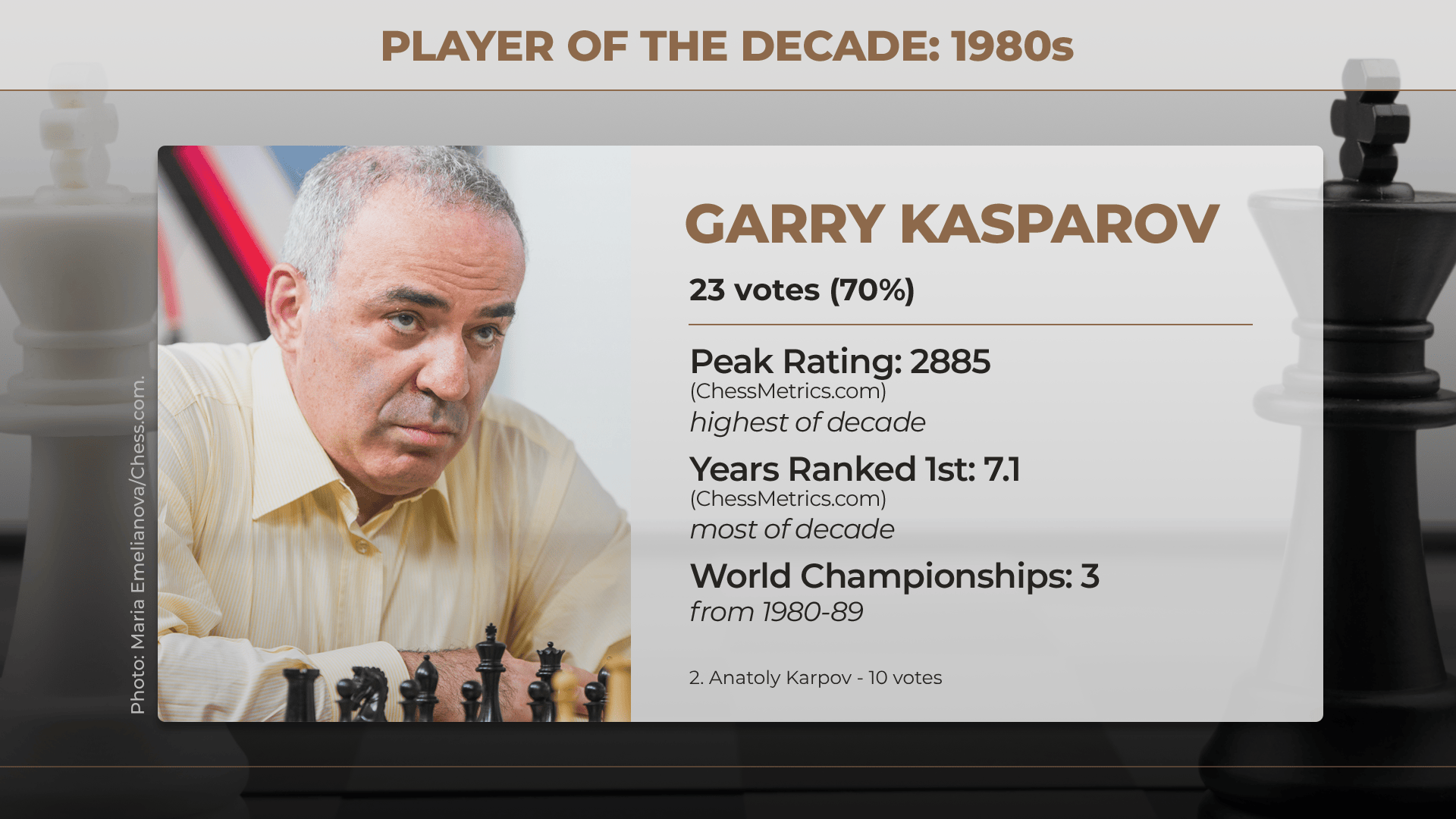
This decade was one of three with just two players receiving votes and had by far the closest margin of them. Kasparov spent the first half of the decade trying to become the world champion and the second half barely fending off Karpov. By late 1982, however, Kasparov already had the best Chess Metrics ratings in the game, and he didn't let them go. He jumped to the top of FIDE's list in January 1984, which Karpov regained in only July 1985 before giving it right back in January 1986.
Even though Kasparov won three of their four world championship matches in the decade (there was a fifth in 1990), they were incredibly close. In total, Kasparov won 17 times against 16 for Karpov in 1980s world championships. Perhaps this partially explains the interesting divide between titled and non-titled voters: Kasparov crushed the non-titled vote 15–3, but only beat Karpov 8–7 among those with titles. After all, Karpov also won a championship in 1981.
| Rank | Player | Votes | Vote % | Titled Votes | Years #1 | Peak Rating | WC Wins |
| 1 | Garry Kasparov | 23 | 70% | 8 | 7.1 | 2885 | 3 |
| 2 | Anatoly Karpov | 10 | 30% | 7 | 2.9 | 2848 | 1 |
1990s

Something about the '90s brings out dominance, as the 1990s were the most crushing decade anyone had enjoyed since probably Lasker in the 1890s. Along with Morphy in the 1850s, Kasparov was one of two players to receive a unanimous Player Of The Decade vote from titled players.
Kasparov began the last decade of the 20th century with his third world championship defense of an eventual five and ended with arguably the greatest game anyone has ever played. He led Chess Metrics all 10 years and was recognized as world champion all 10 years. Just one FIDE rating list in the decade even had him tied with anyone.
But what about... Deep Blue? While perhaps stretching the definition of "player," Deep Blue undoubtedly impacted the chess world the most in this decade and marks a turning point in chess history. – Christopher Schroth
| Rank | Player | Votes | Vote % | Titled Votes | Years #1 | Peak Rating | WC Wins |
| 1 | Garry Kasparov | 31 | 94% | 15 | 10.0 | 2886 | 3 |
| 2 | Viswanathan Anand | 1 | 3% | 0 | 0.0 | 2833 | 0 |
| 3 | Deep Blue | 1 | 3% | 0 | - | - | - |
2000s

In contrast to the 1990s, the 2000s were wide open. Anand won the FIDE world championship tournament in 2000 and was the undisputed world champion at the end of the decade.
Kasparov kept the world's highest rating until his 2005 retirement but lost his world champion title at the start of the decade. At the halfway point, Anand was a clear third in the decade behind Kasparov and Kramnik, but the second half of the decade belonged to Vishy as he won the 2007 World Championship tournament and then the 2008 World Championship match against Kramnik. Meanwhile, Kasparov's inactivity pushed him to third.
But what about... GM Vladimir Kramnik? The 2000s have to be Kramnik. He defeated Kasparov in one of the most impressive matches in history, successfully defended his title twice, and only finally lost the title to Anand in the final match of the decade. – NM Jeremy Kane
| Rank | Player | Votes | Vote % | Titled Votes | Years #1 | Peak Rating | WC Wins |
| 1 | Viswanathan Anand | 18 | 55% | 8 | 1.3 | 2803 | 3 |
| 2 | Vladimir Kramnik | 7 | 21% | 3 | 0.3 | 2811 | 3 |
| 3 | Garry Kasparov | 5 | 15% | 3 | 6.3 | 2851 | 0 |
| 4 | Veselin Topalov | 2 | 6% | 1 | 2.3 | 2813 | 1 |
| 5 | Judit Polgar | 1 | 3% | 0 | 0.0 | 2735 | 0 |
2010s

Who did you expect? Carlsen was not a unanimous choice but did become one of two players along with Morphy to receive all but one vote. He won four world championships, which no one had done in a single decade before. He twice set the record for the highest FIDE rating ever (in 2014 and 2019) and was world number-one for all but the first six months of the decade.
With the voters choosing only a winner in each decade instead of the top two or three, GM Fabiano Caruana was unable to get any support despite winning seven games in a row at the 2014 Sinquefield Cup and drawing every game before the tiebreak games against Carlsen in the 2018 World Championship. Carlsen was just too dominant.
| Rank | Player | Votes | Vote % | Titled Votes | Years #1 | Peak Rating | WC Wins |
| 1 | Magnus Carlsen | 32 | 97% | 14 | 9.5 | 2882 | 4 |
| 2 | Viswanathan Anand | 1 | 3% | 1 | 0.5 | 2817 | 2 |
2020s

The list ends in a rather obvious spot, but you like Magnus, we like Magnus, and Magnus is clearly the best player of the 2020s so far. But he is the most culturally significant? Some differences of opinion there, with GM Hikaru Nakamura earning solid support for all he's done to popularize chess this decade.
| Rank | Player | Votes | Vote % | Titled Votes | Years #1 | Peak Rating | WC Wins |
| 1 | Magnus Carlsen | 24 | 73% | 11 | 3.5 | 2872 | 1 |
| 2 | Hikaru Nakamura | 7 | 21% | 3 | 0.0 | 2775 | 0 |
| 3 | Ian Nepomniachtchi | 1 | 3% | 1 | 0.0 | 2795 | 0 |
| 4 | Ding Liren | 1 | 3% | 0 | 0.0 | 2811 | 1 |
Conclusion
Huge shoutout and thanks to the awesome Chess.com voting panel: @danielrensch, @samcopeland, @peterdoggers, @GMRafpig, @GMKrikor, @immatt64, @kassablanca, @Rakesh, @GMCanty, @mikeklein, @NiranjanNavalgund, @JackRodgers, @AyelenChess, @coachjkane, @ColinStapczynski, @pedropinhata, @chess_dot_tom, @raync910, @ognian_mikov, @SimonMTL, @pat_frap, @Nich, @Bikfoot, @coleskovicz, @chesscomchris, @Craig, @Lauromj, @Merlin2017, and @Marignon! Along with myself and three anonymous voters, we had 33 participants!







